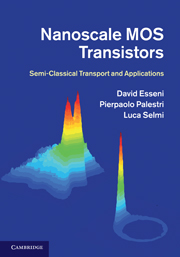Book contents
- Frontmatter
- Contents
- Preface
- Acknowledgements
- Terminology
- 1 Introduction
- 2 Bulk semiconductors and the semi-classical model
- 3 Quantum confined inversion layers
- 4 Carrier scattering in silicon MOS transistors
- 5 The Boltzmann transport equation
- 6 The Monte Carlo method for the Boltzmann transport equation
- 7 Simulation of bulk and SOI silicon MOSFETs
- 8 MOS transistors with arbitrary crystal orientation
- 9 MOS transistors with strained silicon channel
- 10 MOS transistors with alternative materials
- Appendices
- Index
2 - Bulk semiconductors and the semi-classical model
Published online by Cambridge University Press: 05 August 2011
- Frontmatter
- Contents
- Preface
- Acknowledgements
- Terminology
- 1 Introduction
- 2 Bulk semiconductors and the semi-classical model
- 3 Quantum confined inversion layers
- 4 Carrier scattering in silicon MOS transistors
- 5 The Boltzmann transport equation
- 6 The Monte Carlo method for the Boltzmann transport equation
- 7 Simulation of bulk and SOI silicon MOSFETs
- 8 MOS transistors with arbitrary crystal orientation
- 9 MOS transistors with strained silicon channel
- 10 MOS transistors with alternative materials
- Appendices
- Index
Summary
The channel of modern nano-scale MOSFETs is made of crystalline material, shaped in bulk or thin film layers. Since most of the basic electronic properties of crystals can be understood by considering the quantum mechanical behavior of electrons in an infinite periodic arrangement of atoms (bulk crystal), it is reasonable to begin the technical part of this book with a description of the electronic properties of bulk semiconductors.
To this purpose, we start with a short introduction to the basic notions regarding crystal structures and electrons in a strictly periodic potential. The concept of band structure is thus briefly developed. The reader can refer to excellent textbooks for a more detailed treatment of these basic topics [1–3]. We then describe a few methodologies to compute the band structure of electrons and holes in semiconductors and the simplest analytical approximations commonly used to represent the energy relation in proximity to the band edges.
The last sections of the chapter illustrate the effective mass approximation and the foundations of the semi-classical model of carrier transport; namely, the motion of wave-packets in slowly varying potentials and the basics of scattering by rapidly fluctuating potentials.
The chapter sets the stage for the detailed treatment of situations where additional built-in or external potentials cause non-negligible quantum mechanical confinement of the carriers in at least one physical space direction, as, for instance, in the case of the MOSFET inversion layer.
- Type
- Chapter
- Information
- Nanoscale MOS TransistorsSemi-Classical Transport and Applications, pp. 19 - 62Publisher: Cambridge University PressPrint publication year: 2011



